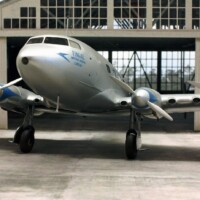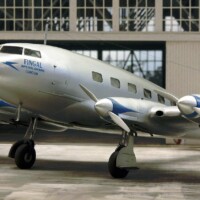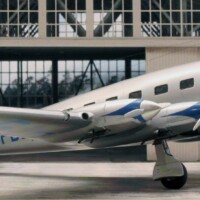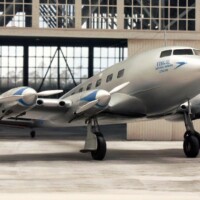A rare bird, but all the more worth seeing: de Havilland's DH.91 "Albatross"!
DH.91 Albatross/ "Fingal
The type designation "Albatross" seems well chosen for the de Havilland DH.91. The wide-span wing tips, which thin out to form an elegant point, are analogous to the wings of the mighty sea bird Albatross. But the planned "habitat" of this aircraft design also seems comparable to this. Like its animal namesake, de Havilland's Albatross was to be encountered over the vastness of the open ocean, for the four-engined aircraft was originally commissioned specifically as a mail plane for transatlantic routes.
Arthur Ernest Hagg, chief designer at de Havilland Aircraft Company Ltd, responded to Air Ministry Specification 35/36, issued in 1936, by producing a large four-engined design that combined the most advanced features of aircraft design of the day into a truly modern design. The DH.91 materialised a remarkable generational change in British aircraft design. After the maiden flight of the DH.91, the era of braced biplanes, rigid landing gears or even half-open cockpits was finally over in civil aircraft construction. For a short time, Great Britain was ahead of the international competition. Comparable aircraft, such as the Fw 200 Condor, did not take off for the first time in Germany until a year later, the DC-4E, which was only built in one piece, did not even get off the ground in the USA until two years later, while the DC-4, which went into series production and was highly successful, did not even take off for its maiden flight until 1942.
A.E. Hagg had been with de Havilland for 17 years by May 1937, the time of the first flight of the DH.91, and was a well-known figure in British aviation. Two years earlier, under his leadership, the successful DH.88 Comet racing aircraft had been built, which was already regarded as an icon of modern aeronautics. The design of the DH.91, translated into the big picture, showed obvious similarities. The advanced features of a retractable landing gear can be found next to a closed cockpit as well as the de Havilland-typical fully aerodynamically clean shape. This is also based on another trademark of the collaboration between A.E. Haggs and Geoffrey de Havilland: like the DH.88, the DH.91 was also largely of wooden construction.
The construction of glued plywood - mainly balsa and cedar - resulted in soft, flowing shapes, compactly enclosed volumes and smooth surfaces; the best prerequisites, therefore, for achieving the goal of a fast and long-range aircraft. A short time later, de Havilland would produce another aircraft that would also become a powerful legend: the DH.98 Mosquito.
By this time, however, A.E Hagg was no longer on board: in 1937 he had left de Havilland to pursue his lifelong interest in fast racing boats in the form of founding the "Walton Yacht Works". Via stations at "D. Napier and Son. Ltd" and the construction of a world speed record aircraft, the "Napier-Heston Racer", he finally came to Airspeed Ltd. Here he was responsible after the war for the development of the large turboprop passenger aircraft AS.57 Ambassador, which clearly bears his signature. A.E. Hagg died in 1985 at the blessed age of 97.
But back to the DH.91 Albatross: as sensational and promising as the birth and first act had turned out to be, the great expectations triggered by this were soon to prove exaggerated and the rest of the short history of the DH.91 Albatross was to run its course in consistently successful but unspectacular steps. Even during the maiden flight and subsequent testing of the two prototypes built, the performance was sufficient, but not exhilarating. Equipped with four "de Havilland Gipsy Twelve" in-line engines with 425 hp each, the "Albatross" reached 340 km/h cruising speed (360 top speed). The 1720 kilometre range was quite respectable, also the low empty weight of 9662kg and a maximum take-off mass of 13,381kg, which was in good relation to it, were positively impressive. Interesting is the ratio of the wingspan to the length of the perfectly spindle-shaped fuselage: 32 metres were measured from wing tip to wing tip, which together with the 21.83 metres length of the fuselage made the DH.91 an impressively large aircraft. To put this into perspective, a Boeing B-17 corresponded exactly to these dimensions except for a few centimetres. The Fw 200, a competitor well comparable to the DH.91, was also exactly of this size with a wingspan of 32 metres and a length of 23.45m.
Two of the seven DH.91s built were delivered as mail and cargo aircraft (G-AEVV Faraday and G-AEVW Franklin), the remaining five were put into service as 22-seat passenger aircraft for Imperial Airways.
All aircraft were given a name beginning with the letter F. After the first delivered aircraft "Frobisher" (G-AFDI), the entirety of the delivered DH.91s was also called "Frobisher Class" in the best British naval tradition. In the years between 1938 and 1943, the DH.91s with the sounding names "Frobisher" (G-AFDI), "Faraday" (G-AEVV), "Franklin" (G-AEVW), "Falcon" (G-AFDJ), "Fortuna" (G-AFDK), "Fingal" (G-AFDL) and "Fiona" (G-AFDM) performed valuable and eventful service as passenger, cargo and courier aircraft. After the beginning of the war, the fast aircraft with their outstanding range were much sought-after courier aircraft, whose missions took them to Lisbon/Portugal, Reykjavik/Iceland or Shannon/Ireland. Destroyed on the ground by German attacks or written off due to crash landings, all but two DH.91s had been destroyed by July 1943. The last two, "Fiona" and "Falcon", were finally decommissioned and scrapped at the end of 1943 due to fatigue of the wooden construction and lack of spare parts.
The model shown here represents DH.91 "Fingal" (G-AFDL). Taken over by "Imperial Airways" (from 1940: BOAC) in 1939, it flew from Croydon on long-haul routes to Brussels, Paris or Zurich. However, "Fingal" was lost after a disastrous crash landing near Pucklechurch, Gloucestershire already in October 1940.
About the kit and the building process
The DH.91 Albatross from the manufacturer Valom is one of those model kits that do not have to spend long months or even years in the archives before they are built: immediately after I had discovered this elegant civil aircraft in the online offer and it had been ordered and delivered, it was also opened and put on the workbench. This unusual haste had to do with the following:
On the one hand, I have known and appreciated kits from Valom for a long time now: you can count on rare or even exotic-interesting prototypes, well-researched shapes as well as comfortably equipped box contents. In addition to resin and etched parts, the often enclosed masking for the clear parts are particularly worthy of appreciation. However, Valom makes an exception with the DH.91: Masks for the clear parts are in vain - and also with etched parts they have held back quite nobly. However, this is easier to cope with on such an elegant model: The few metal parts, such as an instrument panel and a little harness, are completely sufficient for the interior, which is practically invisible later on. Also, the few glazings are quite simple and quickly covered with their own material.
The plastic parts correspond to a higher "short run" standard. This means that there are no locating pins, the parts and their sprues are relatively thick, there are a lot of areas to clean up and some fish skin has to be removed. However, the plastic material of this kit is really the best I have ever seen in a Valom kit. The building process itself is correspondingly smooth, relatively short and, well, low in challenge. I can recommend this building pleasure a little off the beaten track to all those who have a little experience and enjoy improvising - and who are enthusiastic about elegant birds like the DH-91 Albatross.
My conclusion
This is also the second fact that brought the kit to the workbench in no time: de Havilland's engineering skills and elegant design language not only impressed the contemporaries of the real DH.91, but can also inspire today's modellers. When I now look at the completed "Albatross" in 1/72nd scale next to its mostly uniform grey-green military kin, I can really rejoice at what interesting and inspiring civilian models the manufacturers now offer!































This rare bird does look superb, Roland @rosachsenhofer
She does look very ellegant.
Thanks for sharing the historical part, very interesting.
Another superb result out of a challenging kit, Roland! Excellent article, as well!
Well done, Roland, another beautiful model, an interesting and informative narrative, all set off by your hangar.
An excellent rendition of a largely-forgotten beauty @rosachsenhofer - does anyone know whether Lockheed designers conceded any influence of the Albatross on the Constellation's design? I don't believe they were contemporary in origin...
George, interesting question! I have already stumbled across unmotivated Lockheed engineers, who have a reputation for being very interested in the achievements of others, with the AG-4 Crusader and the work of Thomas M. Shelton. However, I cannot contribute anything concrete to your question.
Thank you all for your motivating comments, your interest and feedback are inspiring!
Excellent build, and lovely subject! Well done.
I'm glad to hear that - thank you!
Excellent build of a historic aircraft we don't see often. Yours looks like the real deal.
1 attached image. Click to enlarge.
Thank you very much! One of the peculiarities of this project was to discover how many first-class photos were taken of the DH.91. The boys must have been incredibly proud of the Albatross! 🙂
I think your picture - thank you for it - illustrates that!
To call the DH.91 a ‘beauty’ would be an understatement - just as saying your build looks ‘fabulous’ would also be an understatement.
... and it would be an understatement to say that your comments make me just a little proud and pleased! 🙂 Thank you for your comment!